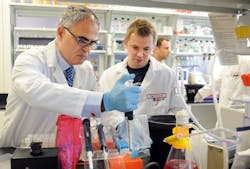In an age of smart phones, where infinite knowledge is at your fingertips, it’s frustrating – and time-consuming — to have to go off site for testing and analysis. Spectro Analytical Instruments has sought to change this with the 26-lb SPECTROSCOUT ED-XRF portable spectrometer, which analyzes elements close to the production line. Thomas Bloomer, Spectro's director of marketing in North America, helps us analyze the features and benefits.
So what does the SPECTROSCOUT do?
It’s the latest generation of high-resolution rapid screening analyzers using energy dispersive X-ray fluorescence (ED-XRF) spectroscopy, designed specifically to conduct lab-quality elemental analyses at the production line. Once a sample is collected from any process point, it can be analyzed rapidly and accurately right at the point of production. The process begins by calibrating the instrument in the lab against a reference sample that contains the desired concentrations of the elements. For manufacturers and processors, the ability to achieve the level of accuracy in elemental analysis once found only in the lab can result in boosting process throughput, reducing costs, and providing production plants with far more flexibility than ever before.
Why was it designed?
Previously, any inductively coupled plasma-optical emission spectrometry (ICP-OES) would have to be done at a lab. In addition to transportation cost and time, that requires extensive sample preparation. This can add hours to the process and in some cases actually be hazardous. If the test is undesirable, the process would have to be repeated.
What was the major focus during the engineering phase?
Achieving affordability without sacrificing performance was a critical factor. SPECTROSCOUT performance levels surpass those of other portable spectrometers at a highly competitive cost that is half that of a dedicated laboratory instrument.
It has true ease-of-operation, including an intuitive interface, simplified software that interacts via a standard computer, and predefined applications packages. We also reduced calibration work. A unique iCAL calibration takes just a single integrated sample and 5 minutes.
Who should use the SPECTROSCOUT?
The SCOUT has been in use for several years, and was initially designed to meet the needs of oil exploration, so that results could be attained at a drilling well site to verify drilling direction.
In 2015 the SCOUT was introduced to the At-Line industry for food, feed, chemical, metal producing, dairy and other markets to offer the same benefit for immediate analysis at a process line. One customer is analyzing iron in milk powder, saving hours by not having to prepare samples for lab analysis. The powder is placed into a sample cup and read directly on the SCOUT for an answer in minutes. The feed industry has also started using the SCOUT to test incoming raw materials for the presence of lead and other contaminants. Performing the analysis on site/at line allows a truck to deliver grain or other feed ingredients, verify it is satisfactory within minutes.
What do you have to do to get started?
The system will come with a factory-installed calibration if it is for one of the applications we promote. You can begin using the instrument out of the box for either lab or at-line analysis. It is always best to add your own samples to the calibration which can be done by running known samples on the SCOUT in the lab and comparing to existing results or results attained from another instrument or process already in use. The time frame from receiving the instrument until it can be used at-line would normally be a couple weeks unless the application has not been done before and the calibration needs to be developed from scratch. This can take up to a month depending on the lab's available time and resources.
How rugged is it?
The system is designed to be used in the field and to be carried over the shoulder. It can withstand drops and will not require re-calibration, although, the system should have a standard ran after such an occurrence just to verify operation. The SCOUT has also been designed to endure certain environmental conditions, such as heat, cold, and moisture.
About the Author
John Hitch
Editor, Fleet Maintenance
John Hitch, based out of Cleveland, Ohio, is the editor of Fleet Maintenance, a B2B magazine that addresses the service needs for all commercial vehicle makes and models (Classes 1-8), ranging from shop management strategies to the latest tools to enhance uptime.
He previously wrote about equipment and fleet operations and management for FleetOwner, and prior to that, manufacturing and advanced technology for IndustryWeek and New Equipment Digest. He is an award-winning journalist and former sonar technician aboard a nuclear-powered submarine where he served honorably aboard the fast-attack submarine USS Oklahoma City (SSN-723).

